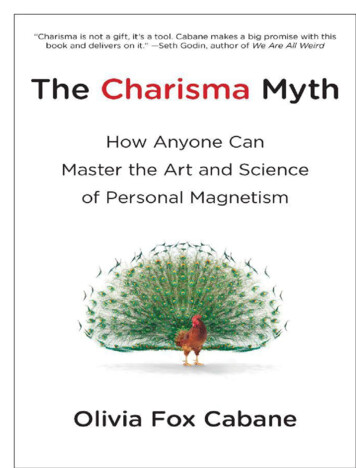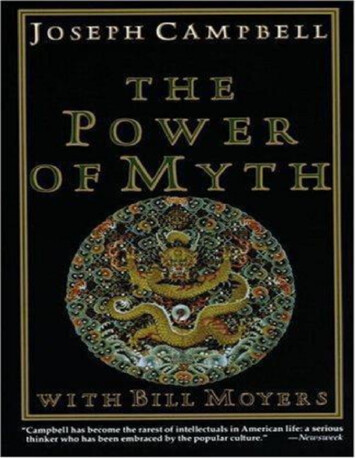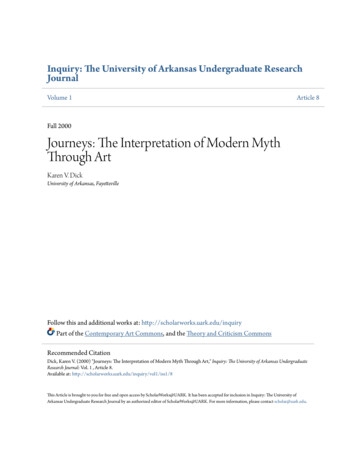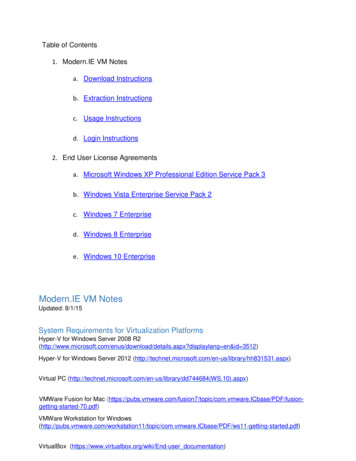
Transcription
The Charisma Myth
The Charisma MythHow Anyone CanMaster the Art and Scienceof Personal MagnetismOlivia Fox CabanePortfolio Penguin
PORTFOLIO / PENGUINPublished by the Penguin GroupPenguin Group (USA) Inc., 375 Hudson Street,New York, New York 10014, U.S.A.Penguin Group (Canada), 90 Eglinton Avenue East, Suite 700,Toronto, Ontario, Canada M4P 2Y3(a division of Pearson Penguin Canada Inc.)Penguin Books Ltd, 80 Strand, London WC2R 0RL, EnglandPenguin Ireland, 25 St. Stephen’s Green, Dublin 2, Ireland(a division of Penguin Books Ltd)Penguin Books Australia Ltd, 250 Camberwell Road, Camberwell,Victoria 3124, Australia(a division of Pearson Australia Group Pty Ltd)Penguin Books India Pvt Ltd, 11 Community Centre, Panchsheel Park,New Delhi–110 017, IndiaPenguin Group (NZ), 67 Apollo Drive, Rosedale, Auckland 0632,New Zealand (a division of Pearson New Zealand Ltd)Penguin Books (South Africa) (Pty) Ltd, 24 Sturdee Avenue,Rosebank, Johannesburg 2196, South AfricaPenguin Books Ltd, Registered Offices:80 Strand, London WC2R 0RL, EnglandFirst published in 2012 by Portfolio/Penguin,a member of Penguin Group (USA) Inc.1 3 5 7 9 10 8 6 4 2Copyright Olivia Fox Cabane, 2012All rights reservedLibrary of Congress Cataloging-in-Publication DataCabane, Olivia Fox.
Cabane, Olivia Fox.The charisma myth : how anyone can master the art and science of personalmagnetism / Olivia Fox Cabane.p. cm.Includes bibliographical references and index.ISBN: 978-1-101-56030-31. Charisma (Personality trait) I. Title.BF698.35.C45C33 2012158.2—dc232011043729Printed in the United States of AmericaSet in Adobe Caslon ProDesigned by Elyse Strongin and Neuwirth & AssociatesNo part of this book may be reproduced, scanned, or distributed in any printedor electronic form without permission. Please do not participate in or encouragepiracy of copyrighted materials in violation of the author’s rights. Purchase onlyauthorized editions.While the author has made every effort to provide accurate telephone numbersand Internet addresses at the time of publication, neither the publisher nor theauthor assumes any responsibility for errors, or for changes that occur afterpublication. Further, the publisher does not have any control over and does notassume any responsibility for author or third-party Web sites or their content.ALWAYS LEARNINGPEARSON
ContentsIntroduction1 Charisma Demystified2 The Charismatic Behaviors: Presence, Power, andWarmth3 The Obstacles to Presence, Power, and Warmth4 Overcoming the Obstacles5 Creating Charismatic Mental States6 Different Charisma Styles7 Charismatic First Impressions8 Speaking—and Listening—with Charisma9 Charismatic Body Language10 Difficult Situations11 Presenting with Charisma12 Charisma in a Crisis13 The Charismatic Life: Rising to the ChallengeConclusion
Recommended ResourcesChapter SummariesCharisma ExercisesAcknowledgmentsNotesAbout the AuthorIndex
IntroductionMARILYN MONROE WANTED to prove a point.It was a sunny summer day in New York City, 1955. With amagazine editor and a photographer in tow, Marilyn walkeddown into Grand Central Terminal. Though it was the middle ofa busy workday and the platform was packed with people, not asingle person noticed her as she stood waiting for the subway.As the photographer’s camera clicked, she boarded the trainand rode along quietly in a corner of the car. Nobody recognizedher.Marilyn wanted to show that just by deciding to, she could beeither glamorous Marilyn Monroe or plain Norma Jean Baker.On the subway, she was Norma Jean. But when she resurfacedonto the busy New York sidewalks, she decided to turn intoMarilyn. She looked around and teasingly asked herphotographer: “Do you want to see her?” There were no grandgestures—she just “fluffed up her hair, and struck a pose.”With this simple shift, she suddenly became magnetic. An auraof magic seemed to ripple out from her, and everything stopped.Time stood still, as did the people around her, who blinked inamazement as they suddenly recognized the star standing in theirmidst. In an instant Marilyn was engulfed by fans, and “it tookseveral shoving, scary minutes” for the photographer to help her
several shoving, scary minutes” for the photographer to help herto escape the growing crowd.1Charisma has always been an intriguing and controversialtopic. When I tell people at conferences or cocktail parties that I“teach charisma,” they immediately perk up and often exclaim,“But I thought it was something that you either have or don’t.”Some see it as an unfair advantage, others are eager to learn,everyone is fascinated. And they are right to be so. Charismaticpeople impact the world, whether they’re starting new projects,new companies, or new empires.Have you ever wondered what it would feel like to be asmagnetic as Bill Clinton or as captivating as Steve Jobs was?Whether you think you already have some charisma and wouldlike to take it to the next level or you’ve been wishing for a bit ofthat magic but think that you just aren’t the charismatic type, Ihave good news: charisma is a skill that you can learn andpractice.What Will Charisma Do for You?Imagine what your life would be like if you knew that themoment you entered a room, people would immediately takenotice, want to hear what you have to say, and be eager to earnyour approval.For charismatic people, this is a way of life. Everyone isimpacted by their presence. People are magnetically drawn tothem and feel strangely compelled to help them in any way theycan. Charismatic people seem to lead charmed lives: they have
can. Charismatic people seem to lead charmed lives: they havemore romantic options, they make more money, and theyexperience less stress.Charisma gets people to like you, trust you, and want to beled by you. It can determine whether you’re seen as a followeror a leader, whether your ideas get adopted, and how effectivelyyour projects are implemented. Like it or not, charisma canmake the world go round—it makes people want to do whatyou want them to do.Charisma is, of course, critical in business. Whether you’reapplying for a new job or want to advance within yourorganization, it will help you achieve your goal. Multipleconcurring studies indicate that charismatic people receive higherperformance ratings and are viewed as more effective by theirsuperiors and subordinates.2If you’re a leader, or aspire to be one, charisma matters. Itgives you a competitive advantage in attracting and retaining thevery best talent. It makes people want to work with you, yourteam, and your company. Research shows that those followingcharismatic leaders perform better, experience their work asmore meaningful, and have more trust in their leaders than thosefollowing effective but noncharismatic leaders.3As Wharton School business professor Robert House notes,charismatic leaders “cause followers to become highly committedto the leader’s mission, to make significant personal sacrifices,and to perform above and beyond the call of duty.”4Charisma is what enables one successful salesman to sell five
Charisma is what enables one successful salesman to sell fivetimes more than his colleagues in the same region. It’s thedifference between entrepreneurs who have investors banging ontheir doors and those who have to beg the bank for a loan.The power of charisma is equally valuable outside of thebusiness environment. It’s useful for the stay-at-home mom whoneeds to influence her children, their teachers, or othercommunity members. It can be an invaluable tool for high schoolstudents who’d like to ace their college interviews or are runningfor leadership roles in student organizations. It can helpindividuals become more popular with their peers and feel moreconfident in social situations. Charismatic physicians are betterliked by patients and are in greater demand, and their patientsare more likely to adhere to the medical treatments theyprescribe. They’re also less likely to be sued when things gowrong. Charisma matters even in research and academia:charismatic individuals are more likely to get published, to attractresearch funding from industry grants, or to teach the mostdesirable courses. The professor who is always surrounded byadmiring students after lectures—that’s charisma, too.It’s Not Magic, It’s Learned BehaviorsContrary to popular belief, people are not simply borncharismatic—innately magnetic from birth. If charisma were aninherent attribute, charismatic people would always becaptivating, and that’s just not the case. Even for the mostengaging superstar, charisma can be present one moment and
engaging superstar, charisma can be present one moment andabsent the next. Marilyn Monroe could “turn off” her charismalike flipping a switch and go completely unnoticed. To turn hercharisma back on, she simply changed her body language.As extensive research in recent years has shown, charisma isthe result of specific nonverbal behaviors,5 not an inherent ormagical personal quality. This is one of the reasons why charismalevels fluctuate: its presence depends on whether or not someoneis exhibiting these behaviors.Have you ever had the experience of feeling totally confident,master of a situation? A moment when people seemed impressedby you—even just one moment of the people around you going“Wow!” We don’t necessarily think of these experiences ascharisma, or consider ourselves charismatic, because we assumethat charismatic people are magnetic every instant of every day.They aren’t.One of the reasons charisma is mistakenly held to be innate isthat, like many other social skills, charismatic behaviors aregenerally learned early in life. In fact, people usually don’tconsciously realize they are learning them. They’re just tryingnew behaviors, seeing the results, and refining them. Eventually,the behaviors become instinctive.Countless well-known charismatic figures worked hard to gaintheir charisma, increasing it step by step. But because we cometo know them at the peak of their charisma, it can be hard tobelieve these superstars weren’t always so impressive.Former Apple CEO Steve Jobs, considered one of the most
charismatic CEOs of the decade, did not start out that way. Infact, if you watch his earliest presentations, you’ll see that hecame across as bashful and awkward, veering from overlydramatic to downright nerdy. Jobs progressively increased hislevel of charisma over the years, and you can see the gradualimprovement in his public appearances.Charisma has come under the scrutiny of sociologists,psychologists, and cognitive and behavioral scientists. It has beenstudied in multiple ways, from clinical laboratory experiments andcross-sectional and longitudinal survey research to qualitativeinterpretative analysis. The subjects of these studies have beenpresidents, military leaders, students of all ages, and businessexecutives from low-level managers to CEOs. Thanks to suchresearch, we now understand charisma as a set of behaviors.What Does Charismatic Behavior Look Like?When we first meet someone, we instinctively assess whetherthat person is a potential friend or foe and whether they have thepower to enact those intentions. Power and intentions are whatwe’re aiming to assess. “Could you move mountains for me?And would you care to do so?” To answer the first question, wetry to assess how much power he or she has. To answer thesecond question, we try to assess how much he or she likes us.When you meet a charismatic person, you get the impression thatthey have a lot of power and they like you a lot.The equation that produces charisma is actually fairly simple.
All you have to do is give the impression that you possess bothhigh power and high warmth, since charismatic behaviors projecta combination of these two qualities. “Fight or flight?” is thepower question. “Friend or foe?” is the warmth question.A final dimension underlies both of these qualities: presence.When people describe their experience of seeing charisma inaction, whether they met Colin Powell, Condoleezza Rice, or theDalai Lama, they often mention the individual’s extraordinary“presence.”Presence is the single most requested aspect of charismawhen I’m coaching executives. They want to increase theirexecutive presence or boardroom presence. And they’re rightto focus on it: presence turns out to be the real core componentof charisma, the foundation upon which all else is built. Whenyou’re with a charismatic master—take Bill Clinton, for example—you not only feel his power and a sense of warm engagement,you also feel that he’s completely here with you, in this moment.Present.Practical MagicCharisma has been turned into an applied science. What thisbook does is translate the science into practical, immediatelyapplicable tools, with measurable results. You’ll learn charisma ina methodical, systematic way, with practical exercisesimmediately useful in the real world. And, unlike those of us wholearned by trial and error, you won’t have to waste any time
learned by trial and error, you won’t have to waste any timefiguring out what works and what doesn’t. You can go straight tothe tried-and-true tools that really do enhance charisma.Becoming more charismatic does involve work—work that issometimes hard, uncomfortable, and even daunting. But it’s alsoincredibly rewarding, both in terms of how you will relate toyourself and how others will relate to you. It involves managingyour mental ecosystem, understanding and attending to your ownneeds, as well as knowing which behaviors inspire others to seeyou as charismatic and learning how to project them.This book will guide you through that process. It will give youconcrete tools for projecting the three crucial aspects ofcharisma: presence, power, and warmth. As you use them, youwill experience an increased sense of personal magnetism—andif it was already strongly present, you’ll gain finer control overthat charismatic power. You’ll learn how to harness it and howto skillfully wield it. You’ll also learn how to choose the rightkind of charisma for your personality and your goals in anysituation.You’ll get an inside peek at what goes on in the minds—andbodies—of charismatic people. I’ll give you insights into what theCEOs I coach wrestle with behind closed doors.What you’ll find here is practical magic: unique knowledge,drawn from a variety of sciences, revealing what charisma reallyis and how it works. You’ll get both the insights and thetechniques you need to apply this knowledge. The world willbecome your lab, and every time you meet someone, you’ll getan opportunity to experiment.
an opportunity to experiment.Once you’ve mastered the basics, you’ll be ready to learnhow to be charismatic even in difficult situations, for instancewhen you’re having a career-changing conversation, dealing witha difficult person, or delivering a presentation. And once youknow how to access charisma at will, you’ll get the insidersecrets to living life as a charismatic person.You’ll learn how to become more influential, more persuasive,and more inspiring. You’ll learn how to exude charisma—theability to move through a room and have people go, “Wow,who’s that?”
1Charisma DemystifiedIN THE TORRID London summer of 1886,William Gladstone wasup against Benjamin Disraeli for the post of prime minister of theUnited Kingdom. This was the Victorian era, so whoever wonwas going to rule half the world. In the very last week before theelection, both men happened to take the same young woman outto dinner. Naturally, the press asked her what impressions therivals had made. She said, “After dining with Mr. Gladstone, Ithought he was the cleverest person in England. But after diningwith Mr. Disraeli, I thought I was the cleverest person inEngland.”Guess who won the election? It was the man who madeothers feel intelligent, impressive, and fascinating: BenjaminDisraeli.Consciously or not, charismatic individuals choose specificbehaviors that make other people feel a certain way. Thesebehaviors can be learned and perfected by anyone. In fact, incontrolled laboratory experiments, researchers were able to raiseand lower people’s levels of charisma as if they were turning a1
dial.1Contrary to commonly held charisma myths, you don’t haveto be naturally outgoing, you don’t have to be physicallyattractive, and you won’t have to change your personality. Nomatter where you’re starting from, you can significantly increaseyour personal charisma and reap the rewards both in businessand in daily life.The most common charisma myth is that you have to benaturally boisterous or outgoing to be charismatic. One of themost interesting research findings is that you can be a verycharismatic introvert. In Western society, we place suchemphasis on the skills and abilities of extroverts that introvertscan end up feeling defective and uncool. But introversion is not aterminal handicap. In fact, as we’ll see, it can be a strongadvantage for certain forms of charisma.It is also a myth that you have to be attractive to becharismatic. Countless charismatic figures were far from fittingclassic standards of beauty. Churchill was not generallyconsidered handsome and certainly not known for his sexappeal. And yet he was one of history’s most influential andpowerful leaders.Yes, good looks do confer some advantage. But it’s verypossible to be charismatic without a striking face or figure. Infact, charisma itself will make you more attractive. Wheninstructed to exhibit specific charismatic behaviors in controlledexperiments, participants’ levels of attractiveness were ratedsignificantly higher than before.2
Last but not least, you won’t have to change your personality.In order to become more charismatic, you don’t have to forceyourself into one particular personality style or do something thatis against your nature.Instead, you will learn some new skills.Through charisma training you will learn how to adopt acharismatic posture, how to warm up your eye contact, and howto modulate your voice in ways that make people pay attention.Three quick tips to gain an instant charisma boost inconversation:Lower the intonation of your voice at the end of yoursentences.Reduce how quickly and how often you nod.Pause for two full seconds before you speak.As you can see, these are simple tweaks, not deep valuechanges. Your personality will stay the same as long as you wantit to.Will these new skills and behaviors feel odd at first? Theymay. But, then, so did brushing your teeth when you first learnedhow, though now (I hope) it’s become a habit you perform eachday without thinking. Like many new skills, charismatic behaviorsmight feel awkward at first, but with practice they will becomesecond nature, like walking, talking, or driving. This book is yourstep-by-step guide to acquiring these behaviors and making themyour own.
We understand that proficiency at chess, singing, or hitting afastball requires conscious practice. Charisma is a skill that canalso be developed through conscious practice, and becausewe’re interacting with people all the time, we get to use ourcharisma tools on a daily basis.I know that a person’s charisma level can be changed throughconscious practice because I’ve helped countless clients increasetheirs in this way. Interviewing people close to my clients beforeand after our work together confirmed that they were able tochange how people perceived them. I’ve also taught thesecharisma tools at both the undergraduate and graduate levels,after UC Berkeley’s business school asked me to create acomplete curriculum for charisma and leadership.If you follow the instructions in this book, you will increaseyour level of charisma. And once these practices become secondnature, they keep operating in the background without yourneeding to give them any thought—and you’ll keep reaping theirrewards from then onward.How This Will Work for YouI’ve reverse-engineered the science of charisma by learning thebehavioral and cognitive science behind it and striving to extractthe most practical tools and techniques. This book helps you putthe science into practice so that you can accelerate your learningcurve.I am offering you the tools that will give you the highest return
I am offering you the tools that will give you the highest returnon your investment and the best, most effective techniques froma broad range of disciplines—from behavioral, cognitive, andneuroscience to meditation; from peak-performance athleticconditioning to Hollywood Method acting.I’ll give you the science when it’s relevant (or fun, orfascinating), and, more important, I’ll give you the practical tools.My goal with this book is to give you techniques you canimmediately apply to gain both the skills and the self-confidencethat lead to outstanding performance.When I’m asked how soon my coaching produces results, Ianswer: In one session, you’ll feel the difference. In two sessions,others will see the difference. In three sessions, you’ll have awhole new presence.However, just reading this book won’t yield its full benefits.You would be shortchanging yourself if you avoided any of theexercises, as odd or even uncomfortable as they may feel attimes. To be successful, you have to be willing to put in the effortof applying what you read. When an exercise asks you to closeyour eyes and imagine a scene, really close your eyes and do it.When I ask you to write out a scenario, grab a piece of paperand a pen that writes.This is the very challenge I bring into the office of everyexecutive who’s ever hired me. There is no substitute for doingthe exercises. Skimming through them with the earnest intentionof completing them “another day” is not enough, nor is doingonly the exercises that seem easy or interesting. If I ask you todo something, it’s for a good reason, and it will have a real
do something, it’s for a good reason, and it will have a realimpact on your level of charisma.Some of the techniques you’ll learn here will give you resultsimmediately, such as learning how to be charismatic whenpresenting to audiences small or large. Others will take weeks tofully unfold. Some might be surprising, like learning how yourtoes can help maximize your charisma potential.When I asked one of my clients what advice he would giveothers about to start this work, he said: “Tell them that: eventhough it can seem intimidating at first, and you’ll be taken out ofyour comfort zone, it’s worth it.” Commit, and do yourhomework.
2The Charismatic BehaviorsPresence, Power, and WarmthCHARISMATIC BEHAVIOR CAN be broken down into three coreelements: presence, power, and warmth. These elements dependboth on our conscious behaviors and on factors we don’tconsciously control. People pick up on messages we often don’teven realize we’re sending through small changes in our bodylanguage. In this chapter, we’ll explore how these signals can beinfluenced. In order to be charismatic, we need to choose mentalstates that make our body language, words, and behaviors flowtogether and express the three core elements of charisma. Sincepresence is the foundation for everything else, that’s where we’llstart.PresenceHave you ever felt, in the middle of a conversation, as if only halfof your mind were present while the other half was busy doingsomething else? Do you think the other person noticed?If you’re not fully present in an interaction, there’s a goodchance that your eyes will glaze over or that your facial reactionswill be a split-second delayed. Since the human mind can readfacial expressions in as little as seventeen milliseconds,1 theperson you’re speaking with will likely notice even the tiniest
delays in your reactions.We may think that we can fake presence. We may think thatwe can fake listening. We believe that as long as we seemattentive, it’s okay to let our brains churn on other things. Butwe’re wrong. When we’re not fully present in an interaction,people will see it. Our body language sends a clear message thatother people read and react to, at least on a subconscious level.You’ve surely had the experience of talking to someone whowasn’t really listening. Maybe they seemed to be just “goingthrough the motions” of listening to you so you wouldn’t beoffended. Somehow, they didn’t seem to be paying full attention.How did you feel then? Brushed off? Annoyed? Just plain bad?As a student in one of my Harvard lectures told me: “Ithappened recently when I was talking to someone—I felt shewasn’t really present. I felt resentful, inferior to whatever wasmore important to her than our conversation.”Not only can the lack of presence be visible, it can also beperceived as inauthentic, which has even worse emotionalconsequences. When you’re perceived as disingenuous, it’svirtually impossible to generate trust, rapport, or loyalty. And it’simpossible to be charismatic.Presence is a learnable skill. Like any other ability (frompainting to playing the piano), you can increase it with practiceand patience. Being present means simply having a moment-tomoment awareness of what’s happening. It means payingattention to what’s going on rather than being caught up in yourown thoughts.Now that you know the cost of lacking presence, try theexercise on the next page to test yourself, see how present youcan be, and learn three simple techniques to immediately boostyour charisma in personal interactions.
Putting It into Practice: PresenceHere are a few techniques for remaining present, adaptedfrom mindfulness disciplines. All you need is a reasonablyquiet place where you can close your eyes (whetherstanding or sitting) for just one minute and a way to keeptrack of time.Set the timer for one minute. Close your eyes and try tofocus on one of the following three things: the soundsaround you, your breathing, or the sensations in your toes.1. Sounds: Scan your environment for sound. As ameditation teacher told me, “Imagine that yourears are satellite dishes, passively and objectivelyregistering sounds.”2. Your breath: Focus on your breath and thesensations it creates in your nostrils or stomachas it goes in and out. Pay attention to one breathat a time, but try to notice everything about thisone breath. Imagine that your breath is someoneyou want to give your full attention to.3. Your toes: Focus your attention on thesensations in your toes. This forces your mind tosweep through your body, helping you to get intothe physical sensations of the moment.So how did that go? Did you find your mind constantly
So how did that go? Did you find your mind constantlywandering even though you were trying your best to be present?As you’ve noticed, staying fully present isn’t always easy. Thereare two main reasons for this.First, our brains are wired to pay attention to novel stimuli,whether they be sights, smells, or sounds. We’re wired to bedistracted, to have our attention grabbed by any new stimulus: Itcould be important! It could eat us! This tendency was key toour ancestors’ survival. Imagine two tribesmen hunting throughthe plains, searching the horizon for signs of the antelope thatcould feed their family. Something flickers in the distance. Thetribesman whose attention wasn’t immediately caught? He’s notour ancestor.The second reason is that our society encourages distraction.The constant influx of stimulation we receive worsens our naturaltendencies. This can eventually lead us into a state of continuouspartial attention, in which we never give our full attention to anysingle thing. We’re always partially distracted.So if you often find it hard to be fully present, don’t beatyourself up. This is entirely normal. Presence is hard for almostall of us. A 2,250-person study coauthored by Harvardpsychologist Daniel Gilbert estimated that nearly half of theaverage person’s time was spent “mind wandering.”2 Evenmeditation masters can find their minds wandering during theirpractice. In fact, this is a common subject of jokes duringintensive meditation retreats (yes, there are such things asmeditation jokes).The good news is that even a minor increase in your capacityfor presence can have a major effect on those around you.Because so few of us are ever fully present, if you can manageeven a few moments of full presence from time to time, you’llmake quite an impact.The very next time you’re in a conversation, try to regularly
The very next time you’re in a conversation, try to regularlycheck whether your mind is fully engaged or whether it iswandering elsewhere (including preparing your next sentence).Aim to bring yourself back to the present moment as often asyou can by focusing on your breath or your toes for just asecond, and then get back to focusing on the other person.One of my clients, after trying this exercise for the first time,reported: “I found myself relaxing, smiling, and others suddenlynoticed me and smiled back without my saying a word.”Don’t be discouraged if you feel that you didn’t fully succeedin the one-minute exercise above. You actually did gain acharisma boost right then and there simply by practicingpresence. And because you’ve already gained the mindset shift(awareness of the importance of presence and the cost of thelack of it), you’re now already ahead of the game. If you were tostop right here and read nothing further, it would be well worth it.Here’s how this could play out for you in a practical, everydaysetting. Let’s say a colleague walks into your office, wanting youropinion on some matter. You have only a few minutes to sparebefore your next meeting, and you’re worried that this might takemore time than you have.If you let your mind continue churning away while he’s talkingto you, not only will you feel anxious and have a hard timeconcentrating, you’ll also give the impression that you’re restlessand not fully present. Your colleague might conclude that youdon’t care enough about him or his problem to really payattention.If instead you remember to use one
The charisma myth : how anyone can master the art and science of personal magnetism / Olivia Fox Cabane. p. cm. Includes bibliographical references and index. ISBN: 978-1-101-56030-3 1. Charisma (Personality trait) I. Title. BF698.35.C45C33 2012 158.2—dc23 2011043729 Printe










